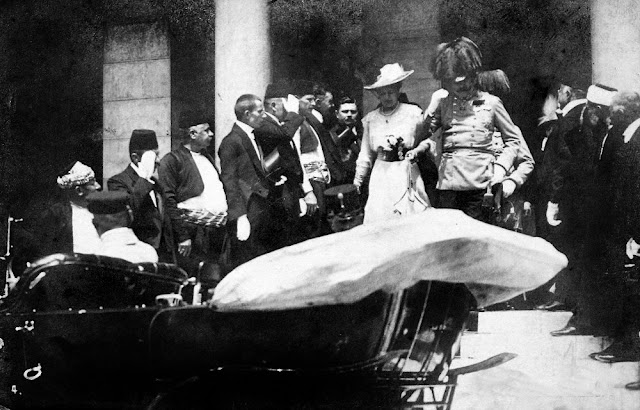On October 5, 1908, the Austro-Hungarian Empire invaded Bosnia and Herzegovina, an ally of Serbia, making relations between the Austro-Hungarian Empire and Serbia extremely tense, the risk of war breaking out was very high. However, Great Britain, France, and Germany tried to cool down that situation by asking Serbia to halt its military action. In return, those countries and Austria-Hungary will concede some economic benefits to Serbia, and if Serbia does not accept it, it will be attacked. Due to pressure from the empires, Serbia had aborted the action.
After the Second Balkan War (1913), the Bosnian issue was
hot again. Terrorist organizations, especially the Black Hand, founded in 1910,
advocated the liberation of Bosnia from Austria-Hungary. Meanwhile, Archduke
Ferdinand of Austria-Hungary advocated maintaining his country's control over
Bosnia. This made Ferdinand a target of the Black Hand.
 |
| Archduke Ferdinand and his wife Sophia Hatek |
On the morning of June 28, 1914, Franz Ferdinand arrived in
Sarajevo, the provincial capital of Bosnia, by train despite all the warnings
of a plot to assassinate him. He was determined to go because he was an
inspector general of the Austro-Hungarian army, so he needed to be present at
the Sarajevo mountain drills and also to introduce his wife Sophia Hatek to the
public.
 |
| The couple, just minutes before the fatal shooting |
While the convoy was moving, six members of the Black Hand Organization were standing among the people walking along with the convoy, with weapons and bombs ready. At exactly 10 o'clock when the convoy ran across the bridge, a young man rushed out from the crowd and threw a bomb at the prince's car. The bomb hit the roof of the car, rolled onto the pavement, and then landed on the front wheel and exploded. The Crown Prince immediately ordered the convoy to stop and sent two people in the entourage to check the victims. Although the wife was slightly injured, she decided to continue. While the car turned right at an intersection, suddenly a dark-haired young man pulled out a gun and fired two times at the car, one hit the Prince's neck and the other hit his wife's stomach.
 |
| The aftermath of the assassination |
After shooting the two, the assassin, named Gavrilo Princip, attempted to commit suicide, but a large crowd surrounded the scene, made him unable to move his arms. He tried to swallow a poison pill but did not die because the pill had expired. He even tried to jump into the river but was eventually caught by the police.
 |
| Gavrilo Princip arrested by the police |
As for the Archduke and his wife, although the car sped
to the hospital and the doctors did their best to treat them, both died the following
day.
The assassination sent shockwaves throughout Europe,
bringing the tension in the Balkans to its peak. In an effort to prevent the war,
Serbia offered to bring this assassination to the international court of Den
Haag in the Netherlands, but Austria did not agree. On July 28, 1914, the
Austro-Hungarian Empire declared war on Serbia, World War I officially broke
out. Over the next four years, the Great War, which used to be called “the war
to end all wars,” claimed tens of millions of lives and affected more than a
billion, ended nothing. The conflicts developed from the postwar
Versailles-Washington Treaty led to an even more devastating World War II twenty
years later.